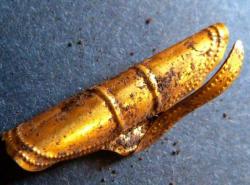INSTITUT SUPERIEUR D'ANTHROPOLOGIE
INSTITUTE OF ANTHROPOLOGY
ONLINE COURSES / COURS A DISTANCE
FALL TERM : OCTOBER 2014
REGISTER NOW
BULGARIE – Bononia - The Bononia fort located on the territory of northwestern Bulgarian city of Vidin is the largest Roman fort along the lower stretch of Danube river, according to an expert. “There is no doubt that Bononia was the largest Roman fort along Lower Danube,” head of the excavation works dr. Zdravko Dimitrov from the National Archaeological Institute at the Bulgarian Academy of Sciences said, as cited by Standart news. The Bononia fort stretched over an area of 200 decares from the modern city center to the Baba Vida fortess. Its walls are 2.70 to 3 meters thick and the diameter of one of the towers is 8-30 meters. Inside tower number 8, archaeologists found coins and ceramics which show that Bononia was built in the 20-30's of the fourth century. “This was a massive fortress system - the largest one to be discovered along the Lower Danube,” Dimitrov explained. The artifacts found in the Bononia fort will be showcased at an exhibition in the spring of 2015. The excavations of the ancient city Ratiaria which is also located in the region of Vidin will start in a month, Standart news informs. The Ministry of Culture has allocated BGN 80 000 for the diggings.
http://www.novinite.com/view_news.php?id=162479#sthash.ABg6Hn9K.dpuf
FRANCE –  Champagne-Ardenne - The skeleton of a German soldier was unearthed in north east France on Friday by a group of local archaeology volunteers. Equipment buried with the soldier, who died nearly 100 years ago and is believed to have been aged between 20 and 25, made it possible to identify him as a member of the German forces. The remains were discovered with other skeletons in the Champagne-Ardenne region of France along with a network of former tunnels and trenches. More than 16 million people lost their lives during the war between 1914 and 1918. Monday marks the official centenary of World War One.
Champagne-Ardenne - The skeleton of a German soldier was unearthed in north east France on Friday by a group of local archaeology volunteers. Equipment buried with the soldier, who died nearly 100 years ago and is believed to have been aged between 20 and 25, made it possible to identify him as a member of the German forces. The remains were discovered with other skeletons in the Champagne-Ardenne region of France along with a network of former tunnels and trenches. More than 16 million people lost their lives during the war between 1914 and 1918. Monday marks the official centenary of World War One.
VIDEO =http://www.telegraph.co.uk/history/world-war-one/11010963/World-War-1-soldiers-skeletons-discovered-in-former-trenches.html
ROYAUME UNI –  Mildenhall - A father and son found eight late Roman coins – which archaeologists believe came from a hoard near Mildenhall – an inquest has heard. The silver coins, known as siliquae, were discovered by Steve Foster and his son Nick in December last year. On Wednesday, an inquest at Bury St Edmunds was told by Faye Minter from Suffolk County Council’s archaeological service that coins from the hoard have been coming to light since October 2001. The rest of the hoard is in Mildenhall Museum and the museum is hoping to acquire the latest find, said Ms Minter.
Mildenhall - A father and son found eight late Roman coins – which archaeologists believe came from a hoard near Mildenhall – an inquest has heard. The silver coins, known as siliquae, were discovered by Steve Foster and his son Nick in December last year. On Wednesday, an inquest at Bury St Edmunds was told by Faye Minter from Suffolk County Council’s archaeological service that coins from the hoard have been coming to light since October 2001. The rest of the hoard is in Mildenhall Museum and the museum is hoping to acquire the latest find, said Ms Minter.
http://www.cambridge-news.co.uk/Newmarket/Coins-discovered-by-father-and-son-are-latest-from-Mildenhall-treasure-hoard-20140804120000.htm?
ROYAUME UNI –  Kirkhaugh - A golden hair tress dating back 4,300 years has been unearthed by a group of children taking part in a summertime archaeological dig. Experts believe the ornament may have been worn by a first-generation metal worker who could have travelled to Britain from overseas in search of gold and copper. The intricately decorated tress, which dates back to about 2,300 BC, a period known as the Copper Age, was found in a burial mound alongside three flint arrowheads and a jet button. Such tresses are very rare and only ten finds have ever been made in Britain, and the new find is the partner of a matching one discovered at Kirkhaugh during an excavation led by Herbert Maryon in 1935.
Kirkhaugh - A golden hair tress dating back 4,300 years has been unearthed by a group of children taking part in a summertime archaeological dig. Experts believe the ornament may have been worn by a first-generation metal worker who could have travelled to Britain from overseas in search of gold and copper. The intricately decorated tress, which dates back to about 2,300 BC, a period known as the Copper Age, was found in a burial mound alongside three flint arrowheads and a jet button. Such tresses are very rare and only ten finds have ever been made in Britain, and the new find is the partner of a matching one discovered at Kirkhaugh during an excavation led by Herbert Maryon in 1935.
http://www.express.co.uk/news/uk/495572/Gold-hair-tress-more-than-4-000-years-old-found-by-kids